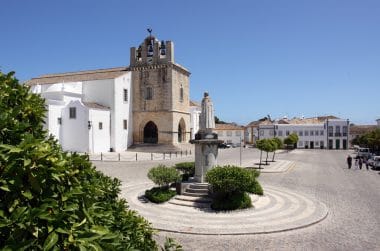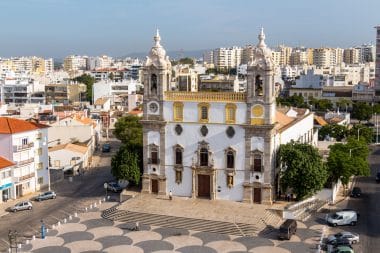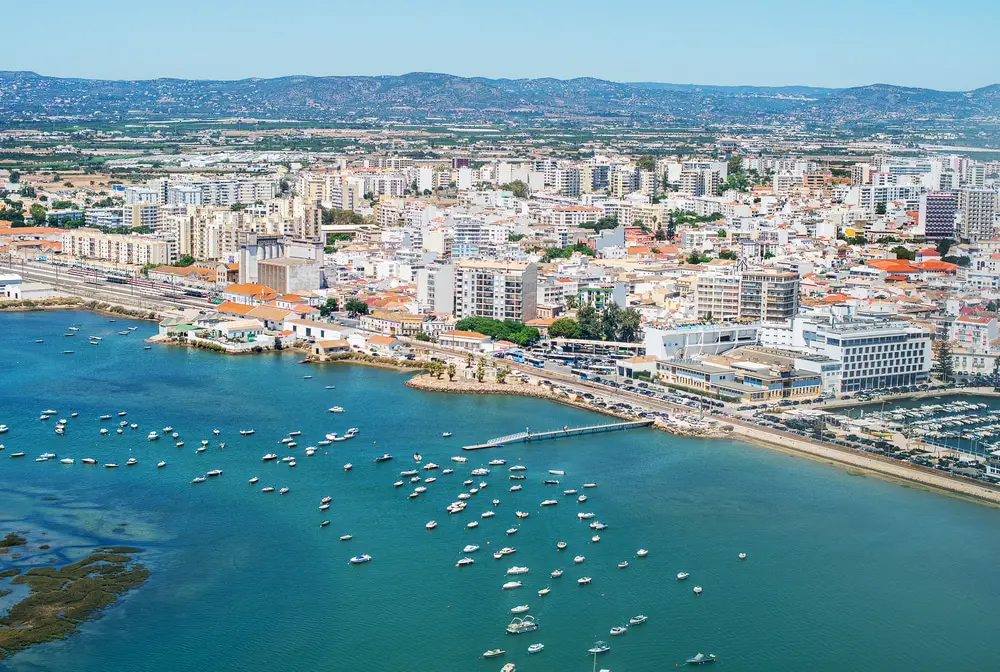In the very south of Portugal, in the multifaceted holiday region of the Algarve, Faro awaits. The city is an important point of reference in the southern Portuguese region. When it comes to the cosmopolitan cities and metropolises of the southern European country, Lisbon and Porto top the list. But Faro is the largest city in the Algarve with about 65,000 inhabitants, and the Algarve is perhaps the most beautiful holiday region in Portugal.
Faro Airport is the gateway to the southern Portuguese region – and Faro itself is the natural first port of call to get to know the beautiful holiday scene. But far from the infrastructural importance, Faro itself has some cultural and natural highlights to offer for travelers – whether the winding old town or the nearby Parque Natural da Ria Formosa. Faro is more than just a transit point on a trip to the Algarve. Often underestimated by tourists, visitors can enjoy a wide variety of facets of the culture, nature and culinary delights of the popular region. Faro itself has a long history that dates back to ancient times. And it is worth pausing after arriving at the airport and getting to know the central city of the Algarve better.
Cultural and historical facets of the coastal city

Once a Phoenician settlement, the early predecessor city of Ossonoba was considered an important hub for the trade in fish, oil and wine in the 1st century. Faro has retained its role as the large infrastructural and economic centre of the Algarve over the centuries to this day. Historically, the city has been shaped by a wide variety of cultures – in the meantime also by the presence of the Moors. In 1540, Faro was granted city rights for the first time, and today the historic old town in particular is a reminder of Faro’s long history. Although the size of the old town does not reach that of metropolises such as Lisbon, it still attracts visitors today with its winding streets and buildings such as the historic town hall of the Arco da Villa. Many of the buildings in the old town are bathed in classic white – with typical architecture of the region. The city is also characterized by its location not far from the lagoon, which is located in the prominent nature reserve Parque Natural da Ria Formosa. It is not only its number of inhabitants that makes Faro stand out among the cities of the Algarve.
Culinary delights and shopping in the heart of the city
A visit to Faro – especially if you are travelling to the Algarve for the first time – can also be a good way to get to know the culinary side of the southern Portuguese region in one of the restaurants. The region is known for its fresh seafood dishes such as bacalhau, fish stew from the cataplana, specialties with shrimp and squid, or the famous piri-piri chicken. As multifaceted as the Algarve region presents itself with its location by the sea and its olive, fig and orange trees, so fascinating is the cuisine, some of which can be discovered in Faro. If you want to combine a culinary tour of Faro and the Algarve with a shopping spree, you should remember Rua de Santo Antonio, which is considered a central shopping street in the city.
Cathedral, Arco da Vila, Jardim Manuel Bivar – Defining sights of Faro

Faro’s Old Town is home to many of the city’s central attractions. In addition to the town hall, this also includes the baroque church of Nossa Senhora do Carmo on the northern edge of the old town. Built between 1719 and 1807, the striking sacred building is considered one of the most impressive church buildings in the city. The church includes the historic Ossuary Capela dos Ossos (also known as the Chapel of Bones), which was built from the bones of over 1000 monks of the Carmelite Order – a macabre sight.
Equally important sacred building is Faro Cathedral, which serves as the seat of the historic Roman Catholic Diocese of Faro. Situated on a fortress hill about 80 meters above sea level, it presents itself as an architecturally outstanding building of the city, which partly incorporates Gothic architecture. The Arco da Vila is considered the gateway to the old town, a historical monument that also functions as a landmark of the city. Inaugurated in 1812, it marks the point where the medieval city gate once stood. The central square of the city is the Jardim Manuel Bivar, which is a scenic stopover when exploring the city. Here, a very special flair unfolds with historic buildings, urban greenery and the sight of the harbour.
Natural Faro
But there is another Faro far away from the urban buildings. The Atlantic beach life can be discovered at Praia de Faro, the city beach of Faro. Especially in the warm summer months, tourists and residents alike are drawn to the sunny coastal strip. The Parque Natural da Ria Formosa characterizes the natural landscapes around the city. The important wetland of the Algarve is an important ecosystem in which a wide variety of species feel at home – and a central natural reference point in the Faro region. Far away from its natural highlights, the city also offers itself as a starting point for excursions into the region. About 10 km outside Faro is the municipality of Estoi, which has a fascinating historical attraction from the 19th century in the form of the Rococo Palace of the Count of Estoi. Olhao is also an important neighboring city with its historical monuments and scenic coastal panorama. Faro thus presents itself as a multifaceted starting point to get to know the Algarve.


